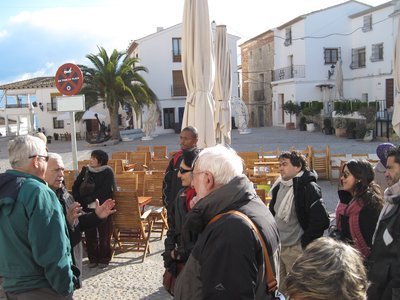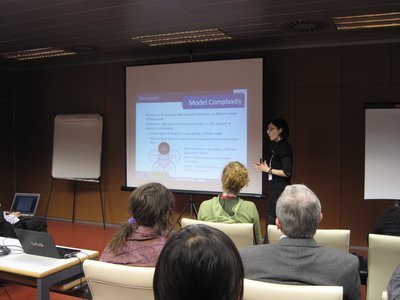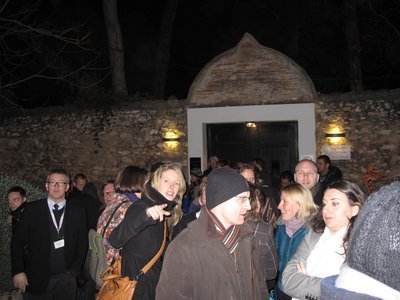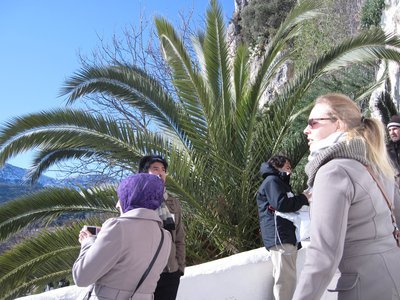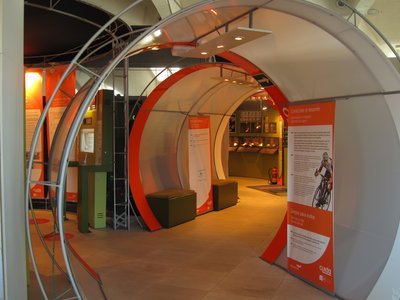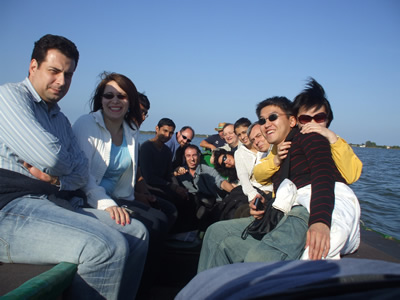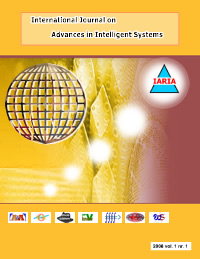AIVR 2025 - The Second International Conference on Artificial Intelligence and Immersive Virtual Reality
April 06, 2025 - April 10, 2025
AIVR 2025: Call for Papers
Onsite and Online Options: In order to accommodate various situations, we are offering the option for either physical presence or virtual participation (pdf slides or pre-recorded videos).
Virtual environments are deemed to shape the future society. Extended virtual world will be seamlessly integrated with the physical world creating digital twins. The convergence of computing, communication, and networking for supporting complex applications (huge data, complex processing algorithms) will benefit from the Artificial Intelligence (AI) progress, especially on Deep learning, Machine learning, and Data Analytics.
Industry, agriculture, finance, health, society, education and almost all domains, including human-systems interactions (interfaces, requests, trust, ethics, etc.) are subject of major evolution with the infusion with AI-based mechanisms into Virtual environments.
The AIVR series focuses on designing and implementing immersive systems, dedicated communities s (children, older adults, game players, students), and across various sectors (medical, training, agriculture, business, industry, etc.)
We solicit both academic, research, and industrial contributions. We welcome technical papers presenting research and practical results, position papers addressing the pros and cons of specific proposals, such as those being discussed in the standard fora or in industry consortia, survey papers addressing the key problems and solutions on any of the above topics short papers on work in progress, and panel proposals.
Industrial presentations are not subject to the format and content constraints of regular submissions. We expect short and long presentations that express industrial position and status.
Tutorials on specific related topics and panels on challenging areas are encouraged.
The topics suggested by the conference can be discussed in term of concepts, state of the art, research, standards, implementations, running experiments, applications, and industrial case studies. Authors are invited to submit complete unpublished papers, which are not under review in any other conference or journal in the following, but not limited to, topic areas.
All topics and submission formats are open to both research and industry contributions.
AIVR 2025 conference tracks:
Designing and implementing AR in immersive systems
VR (Virtual Reality), AR (Augmented), XR (Extended), MR (Mixed) and IVR (Immersive) Reality
Real and virtual environments, augmented reality usability, mobile virtual reality
AR/MR-based co-design, Hybrid 2D/3D user Interface, AR with intelligent tutors
Digital augmented physical games, AR entertainment
Trends in AR, Spatial AR cues
Display and interface adaptations for VR
AR universal design for education
Dedicated AI-support for VR-oriented software systems
eXtended Reality (XR) in assistive systems
Design for users with cognitive disabilities
Design of Mixed Reality (MR) systems
Do-creation-based design of XR technologies
Guidelines for designing XR apps
Human-Virtual collaboration and cohabitation
Collaborative Immersive Virtual Reality (IVR) analytics
Active and Passive Haptics, Haptic Feedback, Visual Feedback, Tangible Interaction
Haptic human-machine Teaming
Robot Teammate
Human trust in a Virtual Assistant
AR teaching materials, mobile AR tutorial systems
Remote collaboration in VR, Collaborative MR
Groupware and MR, MR remote collaboration
Emotion sharing and augmentation in cooperative VR and MR remote collaboration
Education via AI-IVR for co-design processes
Training for news skills via AI-IVR
Training non-experts for developing futuristic scenarios and narratives
Education via IVR
AI and VR in patient rehabilitation and care for older adults
Co-creation design of VR for older adults
Augmented VR for cognitive training in individuals with dementia
Applications of VR/AVR as diagnostic tools and monitoring treatment efficacy
Innovative VR therapies for physical rehabilitation (after injuries or strokes, etc.)
Cognitive rehabilitation using AI and VR (cognitive decline, aging or neurological conditions)
VR for pain management (chronic pain, older adults).
AI-driven personalized care plans (quality of life for older adults)
Monitoring and assessment tools (health parameters, assess progress, and adjust treatments in real-time)
Social interaction platforms (interactions for older adults, loneliness, community)
Virtual reality safety and ergonomics (VR by older adults)
VR projects in geriatric care settings.
AI and VR in geriatrics and the ethical considerations.
AI and VR for early childhood and children with special needs
Educational VR applications for early childhood (engaging and educational content).
Therapeutic uses of VR for special needs ( autism, ADHD, etc.
AI for customized learning pathways (individual needs, learning disabilities, etc.)
Design of interactive learning environments using VR for promoting learning and engagements.
Behavioral analysis and modification via AI: (personalized strategies in real-time)
Safety and privacy in children’s VR (parental controls, content monitoring)
Methods for social skills development through VR
Accessibility in VR
Design for all range of abilities.
Statistics, impact studies and regulations on early VR exposure on children.
Applications of AR and immersive environments across sectors
Virtual fitting rooms and Interactive fashion shows
Integrated real world and immersive world in gaming industry
Medical training and education (teaching complex surgical procedures, 3D holographic views, etc.)
Patient rehabilitation and therapy (virtual activities, anxiety)
Precision farming visualization and training and maintenance of agriculture machinery
AR shopping (visualize before buying) and virtual stores tours (luxury retailers)
Property tours and architectural/ambient pre-design in real-estate area
AR in car design, visualize, and testing in automotive industry
Immersion environments for personalized car, apparels, house interior, physical training, etc.
User in immersive shared and tracking environments
360 Panoramas, 3D Reconstructed Scenes, Omnidirectional cinemographs, Virtual theaters
Cognitive adaptive training in VR and perception in MR
Authentication and shared social data in AR
AR entertainment and digital augmented physical games
AI-based neuroimaging for immersive virtual environments
Tools for tracking user’s movements and interactions in Immersive environments
Superposed immersive and real environments
Human-related analytics in immersive environments
Gaze modeling and interpretation,
Social network loneliness,
Gesture interaction for AR applications
Sharing gestures in remote collaboration, AV mirrors
Eye Gaze and hand gesture sharing
Physiological sensing in VR
Individualized VR for mental health
Generative-AI for human experience development
AI for human digital twins
Integration of XR in primary education
Deadlines:
Submission | Jan 20, 2025 |
Notification | Feb 16, 2025 |
Registration | Feb 28, 2025 |
Camera ready | Mar 05, 2025 |
Deadlines differ for special tracks. Please consult the conference home page for special tracks Call for Papers (if any).
INSTRUCTION FOR THE AUTHORS
Authors of selected papers will be invited to submit extended versions to one of the IARIA Journals.
Publisher: XPS (Xpert Publishing Services)
Archived: ThinkMindTM Digital Library (free access)
Prints available at Curran Associates, Inc.
How to submit to appropriate indexes.
Only .pdf or .doc files will be accepted for paper submission. All received submissions will be acknowledged via an automated system.
Contribution types
- regular papers [in the proceedings, digital library]
- short papers (work in progress) [in the proceedings, digital library]
- ideas: two pages [in the proceedings, digital library]
- extended abstracts: two pages [in the proceedings, digital library]
- posters: two pages [in the proceedings, digital library]
- posters: slide only [slide-deck posted on www.iaria.org]
- presentations: slide only [slide-deck posted on www.iaria.org]
- demos: two pages [posted on www.iaria.org]
FORMATS
Only .pdf or .doc files will be accepted for paper submission. All received submissions will be acknowledged via an automated system.
Final author manuscripts will be 8.5" x 11", not exceeding 6 pages; max 4 extra pages allowed at additional cost.
Helpful information for paper formatting for MS Word can be found here.
There is a community provided LaTeX template: the CTAN package iaria (with full IARIA formatting rules, including IARIA citation style, but for providing citation style it is tightly bound to pdflatex+biblatex+biber). In addition, there is also iaria-lite (not bound to pdflatex+biblatex+biber, but compatible with any TeX stack; thus, it cannot provide the IARIA citation formattings, but only the titlepage and content-related IARIA formatting rules). Based on the iaria package, there is a minimal working example as Overleaf template. When you are using the LaTeX templates, please still adhere to the additional editorial rules.
Slides-based contributions can use the corporate/university format and style.
Your paper should also comply with the additional editorial rules.
Once you receive the notification of contribution acceptance, you will be provided by the publisher an online author kit with all the steps an author needs to follow to submit the final version. The author kits URL will be included in the letter of acceptance.
We would recommend that you should not use too many extra pages, even if you can afford the extra fees. No more than 2 contributions per event are recommended, as each contribution must be separately registered and paid for. At least one author of each accepted paper must register to ensure that the paper will be included in the conference proceedings and in the digital library, or posted on the www.iaria.org (for slide-based contributions).
CONTRIBUTION TYPE
Regular Papers (up to 6-10 page article -6 pages covered the by regular registration; max 4 extra pages allowed at additional cost- ) (oral presentation)
These contributions could be academic or industrial research, survey, white, implementation-oriented, architecture-oriented, white papers, etc. They will be included in the proceedings, posted in the free-access ThinkMind digital library and sent for indexing. Please submit the contributions following the instructions for the regular submissions using the "Submit a Paper" button and selecting the appropriate contribution type. 12-14 presentation slides are suggested.
Short papers (work in progress) (up to 4 pages long) (oral presentation)
Work-in-progress contributions are welcome. These contributions represent partial achievements of longer-term projects. They could be academic or industrial research, survey, white, implementation-oriented, architecture-oriented, white papers, etc. Please submit the contributions following the instructions for the regular submissions using the "Submit a Paper" button and selecting the contribution type as work in progress. Contributors must follow the conference deadlines, describing early research and novel skeleton ideas in the areas of the conference topics. The work will be published in the conference proceedings, posted in the free-access ThinkMind digital library and sent for indexing. For more details, see the Work in Progress explanation page. 12-14 presentation slides are suggested.
Ideas contributions (2 pages long) (oral presentation)
This category is dedicated to new ideas in their very early stage. Idea contributions are expression of yet to be developed approaches, with pros/cons, not yet consolidated. Ideas contributions are intended for a debate and audience feedback. Please submit the contributions following the instructions for the regular submissions using the "Submit a Paper" button and selecting the contribution type as Idea. Contributors must follow the conference deadlines, describing early research and novel skeleton ideas in the areas of the conference topics. The work will be published in the conference proceedings, posted in the free-access ThinkMind digital library and sent for indexing. For more details, see the Ideas explanation page. 12-14 presentation slides are suggested.
Extended abstracts (2 pages long) (oral presentation)
Extended abstracts summarize a long potential publication with noticeable results. It is intended for sharing yet to be written, or further on intended for a journal publication. Please submit the contributions following the instructions for the regular submissions using the "Submit a Paper" button and selecting the contribution type as Extended abstract. Contributors must follow the conference deadlines, describing early research and novel skeleton ideas in the areas of the conference topics. The work will be published in the conference proceedings, posted in the free-access ThinkMind digital library and sent for indexing. 12-14 presentation slides are suggested.
Posters (paper-based, two pages long) (oral presentation)
Posters are intended for ongoing research projects, concrete realizations, or industrial applications/projects presentations. The poster may be presented during sessions reserved for posters, or mixed with presentation of articles of similar topic. A two-page paper summarizes a presentation intended to be a POSTER. This allows an author to summarize a series of results and expose them via a big number of figures, graphics and tables. Please submit the contributions following the instructions for the regular submissions using the "Submit a Paper" button and selecting the contribution type as Poster Two Pages. Contributors must follow the conference deadlines, describing early research and novel skeleton ideas in the areas of the conference topics. The work will be published in the conference proceedings, posted in the free-access ThinkMind digital library and sent for indexing. 8-10 presentation slides are suggested. Also a big Poster is suitable, used for live discussions with the attendees, in addition to the oral presentation.
Posters (slide-based, only) (oral presentation)
Posters are intended for ongoing research projects, concrete realizations, or industrial applications/projects presentations. The poster may be presented during sessions reserved for posters, or mixed with presentation of articles of similar topic. The slides must have comprehensive comments. This type of contribution only requires a 8-10 slide-deck. Please submit the contributions following the instructions for the regular submissions using the "Submit a Paper" button and selecting the contribution type as Poster (slide-only). The slide-deck will be posted, post-event, on www.iaria.org.
8-10 presentation slides are suggested. Also a big Poster is suitable, used for live discussions with the attendees, additionally to the oral presentation.
Presentations (slide-based, only) (oral presentation)
These contributions represent technical marketing/industrial/business/positioning presentations. This type of contribution only requires a 12-14 slide-deck. Please submit the contributions following the submission instructions by using the "Submit a Paper" button and selecting the contribution type as Presentation (slide-only). The slide-deck will be posted, post-event, on www.iaria.org.
12-14 presentation slides are suggested.
Demos (two pages) [posted on www.iaria.org]
Demos represent special contributions where a tool, an implementation of an application, or a freshly implemented system is presented in its alfa/beta version. It might also be intended for thsoe new application to gather the attendee opinion. A two-page summary for a demo is intended to be. It would be scheduled in special time spots, to ensure a maximum attendance from the participants. Please submit the contributions following the submission instructions by using the "Submit a Paper" button and selecting the contribution type as Demos. The Demos paper will be posted, post-event, on www.iaria.org.
Tutorial proposals
Tutorials provide overviews of current high interest topics. Proposals should be for 2-3 hour long. Proposals must contain the title, the summary of the content, and the biography of the presenter(s). The tutorial slide decks will be posted on the IARIA site.
Please send your proposals to tutorial proposal
Panel proposals
The organizers encourage scientists and industry leaders to organize dedicated panels dealing with controversial and challenging topics and paradigms. Panel moderators are asked to identify their guests and manage that their appropriate talk supports timely reach our deadlines. Moderators must specifically submit an official proposal, indicating their background, panelist names, their affiliation, the topic of the panel, as well as short biographies. The panel slide deck will be posted on the IARIA site.
Please send your proposals to panel proposal
